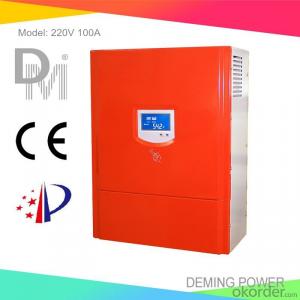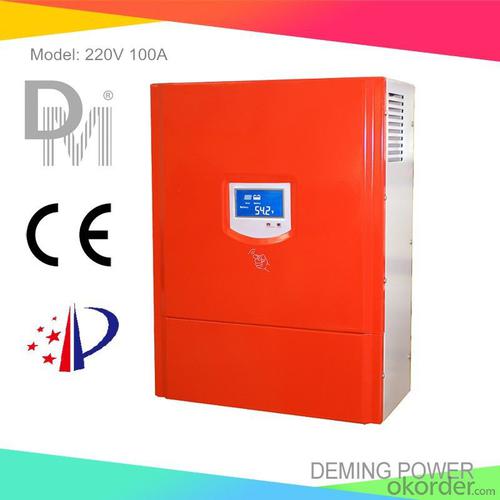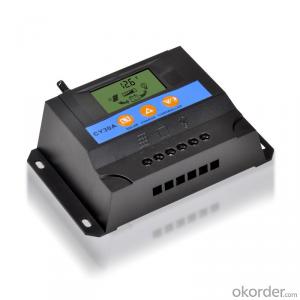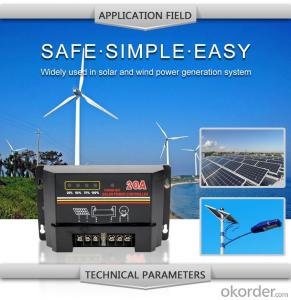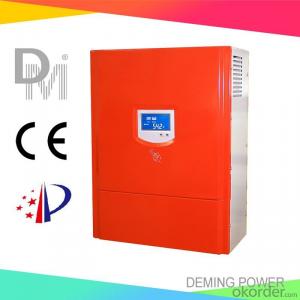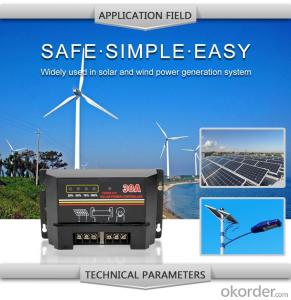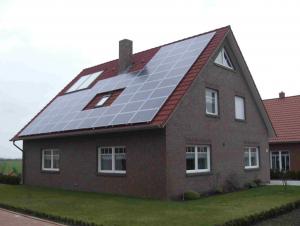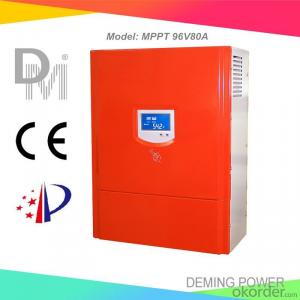Mastervolt Solar Charge Controller 220V 100A - Best Price for Solar Power System
- Loading Port:
- Qingdao
- Payment Terms:
- TT OR LC
- Min Order Qty:
- 1 PCS
- Supply Capability:
- 500 PCS/month
OKorder Service Pledge
OKorder Financial Service
You Might Also Like
Properties of the solar charge controller
1. Design for off-grid solar power system.
2. Applicable to different kinds of batteries.
3. Modular design with simple structure and easy maintenance.
4. Automatic power control function.
5. LCD display: Solar panel current, solar panel voltage, solar panel power, battery group voltage, charge current.
6. Perfect protection function: Solar reverse charge protection, Solar reverse connection protection, Battery reverse connection protection, Battery overcharge protection, Battery over current protection etc ,thus the system has higher reliability.
Technical parameters of the solar charge controller
Model | 220V100A |
Battery group rated voltage | 220Vdc |
PV open circuit voltage(Vdc) | 500V |
PV Rated current | 100A |
PV Max. power | 22000Wp |
Input DC Voltage Range(Vdc) | 175-260Vdc |
Input PV module road number | 2 |
Function | Auto stop charge, auto recharge voltage; Protection: connecting contrary, over current, short circuit, over heat etc. |
Display mode | LCD |
Display content | solar panel voltage, solar panel current, solar panel power, battery voltage, charge current |
Floating Charge Voltage (adjustable) | 248Vdc |
Stop charge voltage | 260Vdc |
Recharge voltage | 243Vdc |
Voltage drop between PV and battery | 1.5V |
Max itself power consumption | 100mA-150mA |
Work environment temperature | -30-60°C |
Relative humidity | <90% No condensation |
Applicable altitude | <3000m The rated power should be reduced when it is higher than 2000m |
Noise (1m) | <40dB |
Degree of protection | IP20(Indoor) |
Cooling method | Forced air cooling |
*Communication interface (optional) | RS485/USB/GPRS/Ethernet |
*Temperature compensation(optional) | -4mv/°C/2V,-35°C~+80°C,Accuracy:±1°C |
Package size (mm) | Wood case, 750*380*590mm |
Package Weight(kg) | 36Kg |
*Above parameter only for reference. Could be custom made to user specifications.
- Q: Can a solar controller be used with a solar-powered hospitality industry?
- Yes, a solar controller can be used with a solar-powered hospitality industry. A solar controller is an essential component of a solar power system that regulates the flow of energy from the solar panels to the batteries or grid, ensuring optimal charging and preventing overcharging or damage to the system. In the hospitality industry, where energy demands can vary and be substantial, a solar controller helps manage and maximize the use of solar power, allowing for efficient and sustainable operations.
- Q: Can a solar controller be used with a solar-powered signage system?
- Yes, a solar controller can be used with a solar-powered signage system. A solar controller helps regulate the flow of electricity from the solar panels to the signage system, ensuring optimal performance and preventing overcharging of the batteries. It also helps monitor and control the charging process, providing efficient power management for the signage system.
- Q: Can a solar controller be used with a generator backup system?
- Yes, a solar controller can be used with a generator backup system. The solar controller regulates the charge coming from the solar panels, ensuring the batteries are charged efficiently. When a generator is used as a backup power source, the solar controller can still be connected to manage the charging process and prevent overcharging. This allows for seamless integration and optimal utilization of both solar and generator power in a hybrid system.
- Q: Can a solar controller be used with a solar-powered research facility?
- Yes, a solar controller can be used with a solar-powered research facility. A solar controller is essential for managing and regulating the flow of electricity from the solar panels to the facility's power system. It helps optimize the energy production, prevent overcharging of batteries, and protect the equipment from voltage fluctuations. Using a solar controller ensures efficient and reliable power supply, making it an integral component of a solar-powered research facility.
- Q: Can a solar controller be used with solar-powered telecommunications equipment?
- Yes, a solar controller can be used with solar-powered telecommunications equipment. A solar controller helps regulate and optimize the charging of batteries connected to solar panels, ensuring efficient and safe operation of the equipment. It helps manage the flow of power from the solar panels to the batteries, preventing overcharging and over-discharging, which can extend the lifespan of the batteries and improve the overall performance of the telecommunications equipment.
- Q: Can a solar controller be used with solar-powered water heaters?
- Yes, a solar controller can be used with solar-powered water heaters. A solar controller helps regulate the flow of energy from the solar panels to the water heating system, ensuring efficient and optimal performance. It helps monitor and control factors like temperature, pump speed, and water flow, enhancing the overall effectiveness of the solar-powered water heating system.
- Q: The controller has a water setting thawing no other settings inside the regular thawing temperature constant water level
- This can only rely on the sun to pull. Sun drying water is not enough water, you can only install a heating tube pull! Also choose a thick power cord. Thin line not work. Control can not pass your controller, an external air switch on it.
- Q: Does a solar controller have surge protection?
- Surge protection is indeed incorporated in a solar controller, ensuring the safety of the solar panels and other system components. Its significance lies in shielding against voltage spikes and power surges that may harm or even obliterate the solar controller and associated devices. These spikes can arise from lightning strikes, grid fluctuations, or other electrical disturbances. By absorbing and redirecting these voltage spikes, surge protection within the solar controller guarantees the smooth and secure functioning of the solar system.
- Q: How does a solar controller handle lightning protection?
- A solar controller typically handles lightning protection by incorporating surge protection devices and grounding techniques to divert the high voltage and current caused by lightning strikes away from the solar system. This helps prevent any damage to the solar panels, batteries, and other components connected to the controller.
- Q: How do you protect a solar controller from lightning strikes?
- To protect a solar controller from lightning strikes, it is recommended to install surge protection devices (SPDs) on both the solar panel side and the controller side. These SPDs divert the excess voltage caused by lightning strikes, preventing it from damaging the controller. Additionally, grounding the system properly and using high-quality cables and connectors can also help in minimizing the risk of damage from lightning strikes.
Send your message to us
Mastervolt Solar Charge Controller 220V 100A - Best Price for Solar Power System
- Loading Port:
- Qingdao
- Payment Terms:
- TT OR LC
- Min Order Qty:
- 1 PCS
- Supply Capability:
- 500 PCS/month
OKorder Service Pledge
OKorder Financial Service
Similar products
Hot products
Hot Searches
Related keywords
